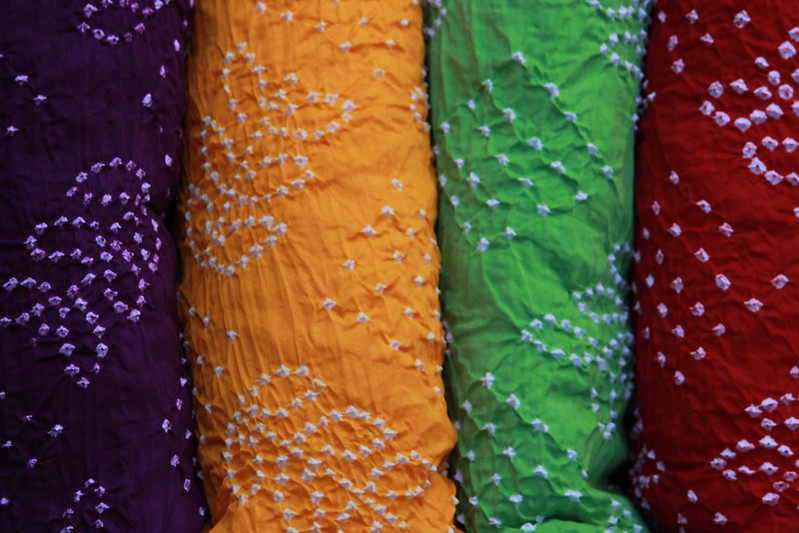Among the various types of sarees that our country is famous for, the Rajasthani sarees occupies a special place. Rajasthani saree is better known as the Bandhani saree or Bandhej saree.

The Craftsmanship Behind Bandhani Saree
As the word suggests, Bandhani saree involves the process of tying small portions of the cloth at regular intervals. This is intricate work as the highly talented artisans use their fingernails to pluck the cloth to form the tiny bindings. Hence the process of tie and dye begins. An unbroken thread is used for tying the same. There are times when even rubber bands are used but the procedure of tying with thread shows better results.
Details of the Process
The tying techniques go by various names such as Mothra, Ekdali, and Shikari depending on the manner in which the cloth is tied. The final products too have various names attributed to them. These include Khombi, Ghar Chola, Patori, and Chandrokhani.
Compelling patterns emerge after completing the process but that is only half the battle won because the process of dying is still to be carried out. The dyeing process is not as simple, the reason being that while ‘tying’ the fabric in the initial stages ‘resists’ have formed (because of the impermeable thread ) which ‘resist’ or prevent the dye from coloring a major part of the fabric.
There can be different ways of overcoming the problem which include the application of dye before the ‘resists’ happen. Further multi sequential dye and resist procedures can be carried out to achieve the result. Special types of resists which include stitching and stencils can be used.
The final product is a treat to the eyes as it is characterized by patterns like dots, stripes, waves, and squares. The patterns have been given different names. Chandrakala, Bavan Baug, Shikari are a few that are famous with the connoisseurs of sarees. Bandhani sarees as pretty as they are limit themselves as far as the scheme of colors is concerned. You would find them mostly in the following colors – yellow, red, blue, green, and black.
The History of Bandhani Saree
Let’s delve a little into the history of Bandhani sarees and for that, we will have to go back as far as the Indus Valley Civilization. That means Bandhani sarees and the dyeing process was visible as early as 4000 B.C.
The Ajanta caves vouch for Bandhani sarees as they depict the Bandhani dots in the paintings of Buddha which date back to the 6th century. There are eulogies of Bandhani sarees from the times of Alexander – the Great.
Cultural Status of Bandhani Saree
In India, there is a sacred touch associated with all that’s Bandhani, especially in the states of Rajasthan and Gujarat. Superstition has it that a woman adorned in a Bandhani saree invites good luck. Bandhani is especially popular with brides-to-be. Fine Bandhani work can be seen on the Gujarati Gharchola as also on the Panetar. The same can be said for new births. To welcome newborns, women went out of their way to make sure that they wore Bandhani sarees at the time of the child’s birth.
Bandhani with its various patterns and colours is used as an indicator of castes and communities in Rajasthan, that is it’s not limited to women, Bandhani work is used to highlight the turbans of menfolk as well. The colour of Bandhani saree tells you at which life stage a woman currently is. Red conveys that the woman is married, for motherhood the yellow colour comes into play while to indicate fertility the green colour is used.
Types of Bandhani Saree
Finally, let’s explore the different types of Bandhani sarees –
Jhankaar Bandhani
Jhankaar Bandhani saree is characterized by very colorful and lively colors, it boasts of very fine motifs. It is exclusive of the white or light dots which are found in other styles of Bandhani and instead involves the use of bright red or maroon dots.
Borjaal
This type of saree focuses on creating a mesh of the fibers with a prominent inter-play of colors and dots. It has a huge customer base with Marwaris being on the top of the list. Such sarees are also available in georgettes.
Color Discharge Bandhani
The modus operandi of manufacturing this type of Bandhani sarees is exactly opposite to that of other types of Bandhani sarees. The normal method involves using darker colors over lighter ones but here the process is reversed. One example of the same would be placing red dots over a pale yellow foundation.
